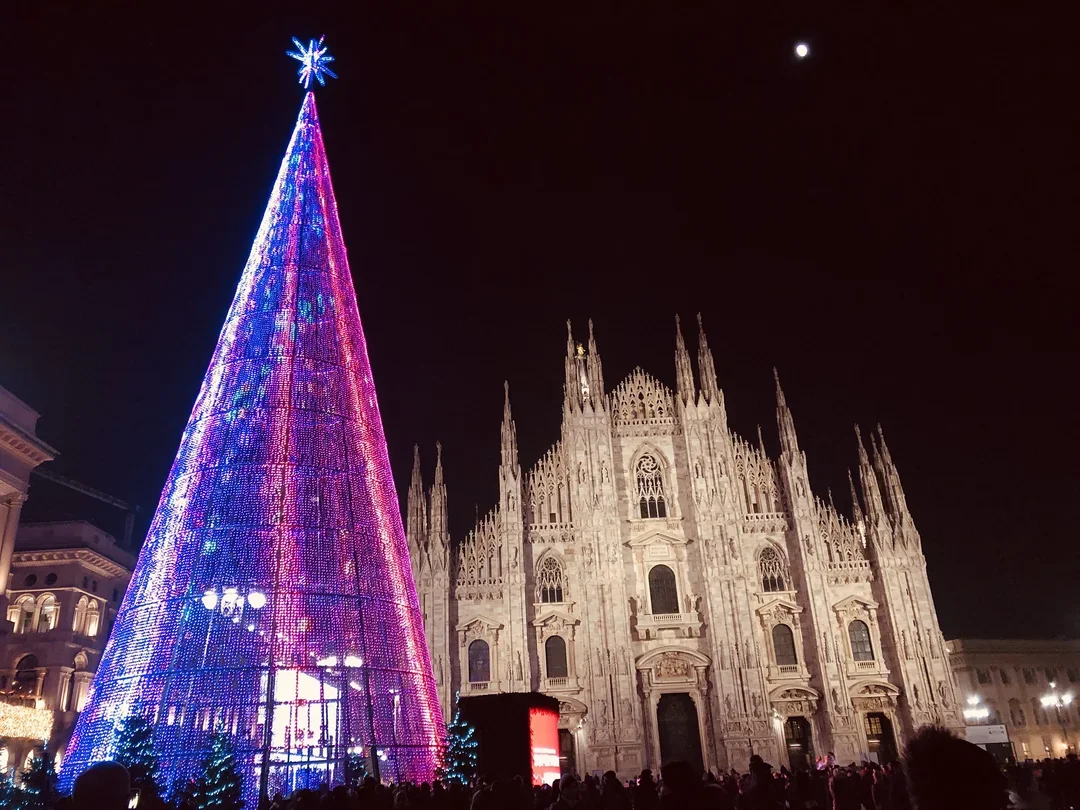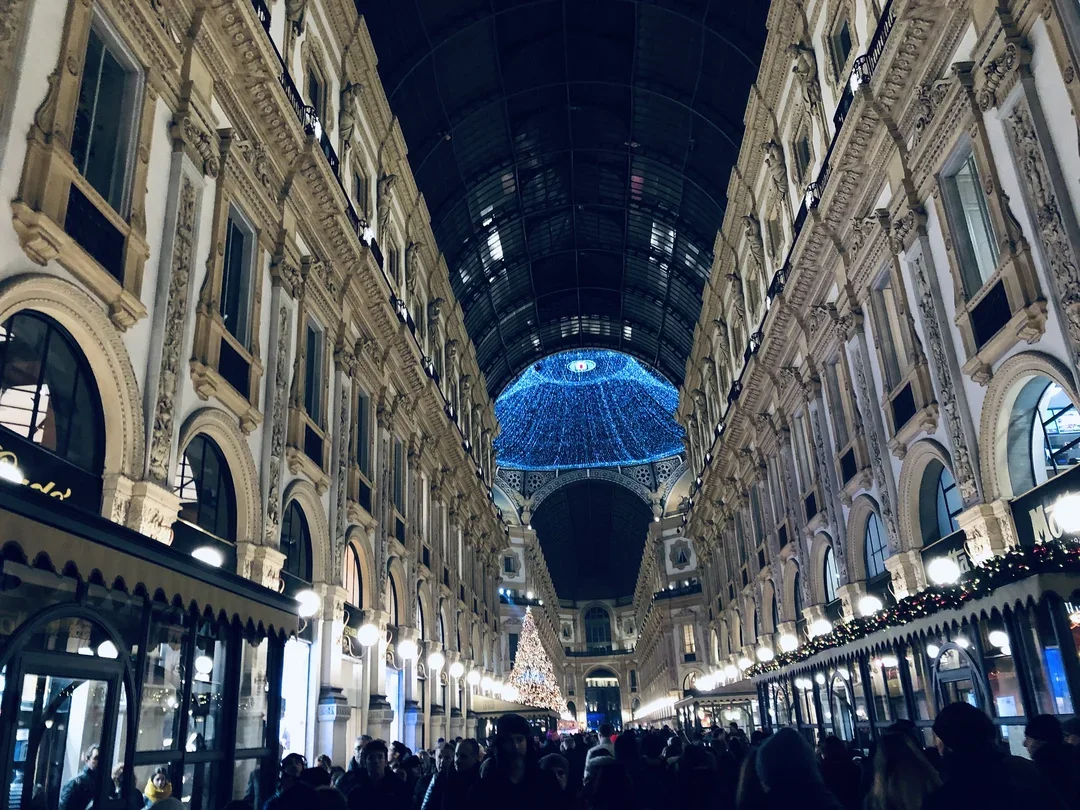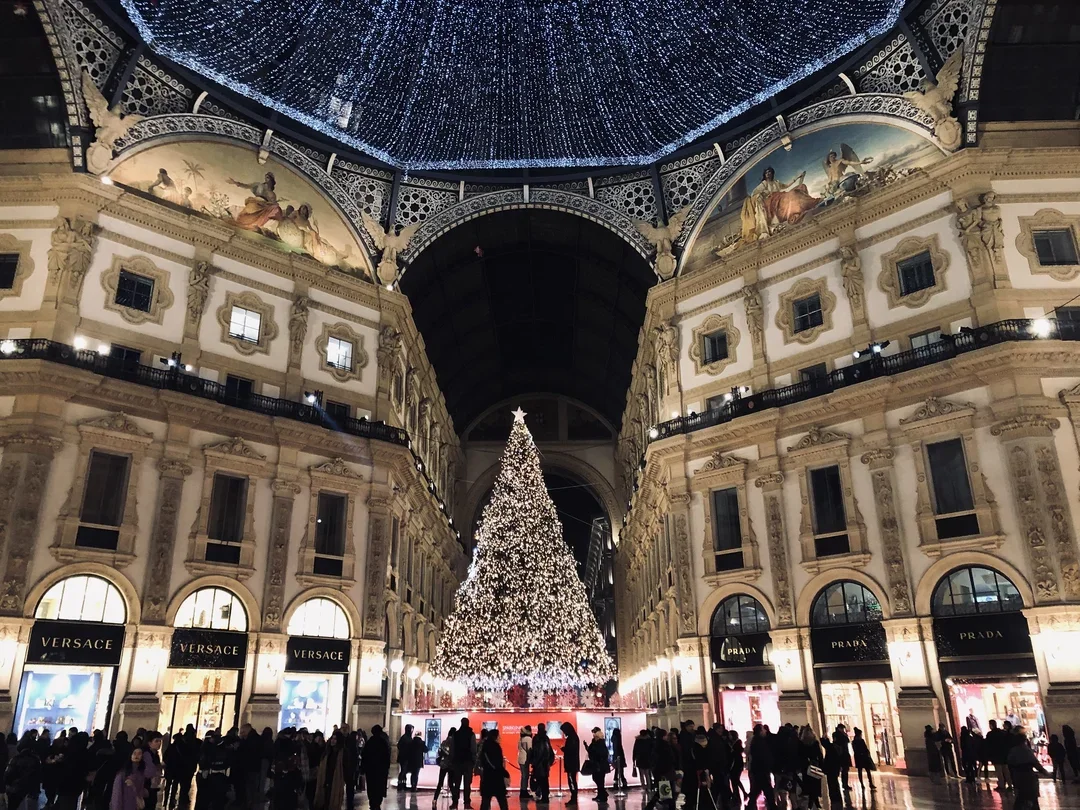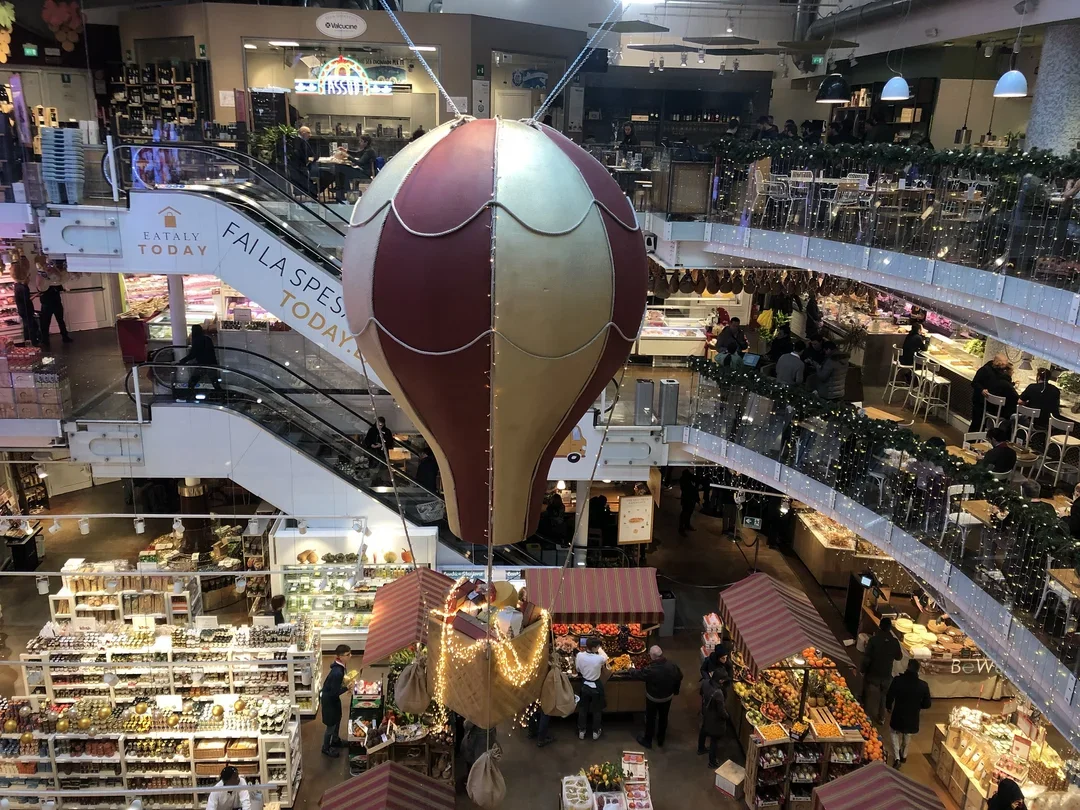FM Alisa Melekhina’s photo report depicts her winter travels in Europe where she was one of the two Americans competing in the Seville Open chess tournament January 10-18, 2020. She also shares photos from her travels before and after in Milan and Madrid. Although the subject of this article was only a couple months ago, it feels like a time capsule, written in happier times right before the COVID-19 pandemic broke out and before travel restrictions were in place. The Seville Open chess tournament, held annually in mid-January, is one of the best kept secrets from US players. Throughout the nine-day, one-round-a-day event from January 10-18, 2020, the weather was, as promised, in the steady 60s Fahrenheit.
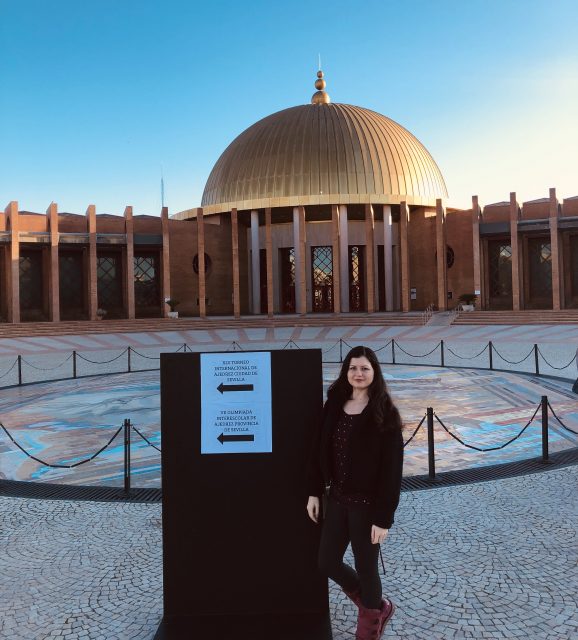 Alisa in front of the playing hall. The tournament was held at the FIBES Congress and Exhibition Center, itself a stunning work of architecture.
Alisa in front of the playing hall. The tournament was held at the FIBES Congress and Exhibition Center, itself a stunning work of architecture.This was a significant draw to me as I was contemplating escape options from the frigid winters in NYC where I am usually based. (See Alisa’s finale recap on the NYC corporate chess league held in the fall). I had looked up average January temperatures in major European cities, which confirmed that Seville’s temperatures are the warmest due to its location in the south of Spain. If I was more ambitious, I might have combined a trip to Seville with a visit to Morocco, a not uncommon route a few of my friends have undertaken given the proximity. However, I decided to stick with nearby European cities and keep it simple. Due to the six-hour time difference between Spain and NY Eastern Time, it was important to arrive a few days in advance to acclimate. Given I was already dipping into my vacation days to play in the tournament, I only had a few days before and after to tack on. (Listen to the recent Ladies Knight Podcast with Alisa where among other topics, we discuss challenges for working adults to stay competitive). With this in mind, I chose Milan, Italy to explore first. Since my vacation preference is large, cosmopolitan cities, Milan made sense. While its temperatures track the cold east coast, I figured it would have more indoor activities (read: shopping) available, and it would be possible to see most of it in a short period of time. The plan was to meet up there with (Canadian GM-elect) Raja Panjwani, who was in the midst of his own European chess tour to achieve the rating needed for his GM title. Raja had just finished competing in an event elsewhere in Italy. He planned to play in Seville before heading to the Gibraltar Masters, which was conveniently scheduled to begin a few days after the conclusion of the Seville Open. Fortunately, we happened to arrive in Milan on January 6, the very last day the Christmas lights were brightly on display in the iconic Duomo area. I was greeted by these breathtaking views of the historic cathedral and surrounding luxury shops.
A few days and a cheap RyanAir flight later, I was in Seville and mostly recovered from jet lag. An essential for American travelers, yes: Seville does have uber. The UberX option is fairly reasonable, and only professional drivers are on the app. The airport driver was very friendly, earnest, and pleasant. In fact, that was my prevailing experience with all of the people I encountered in Seville. It has a small-town feel where the people are genuinely friendly and laid-back. The tournament is held in a grand exhibition hall outside of the downtown area off a major road. This made it easier to navigate, given the roads in downtown Seville are much narrower and more conducive to walking than driving. 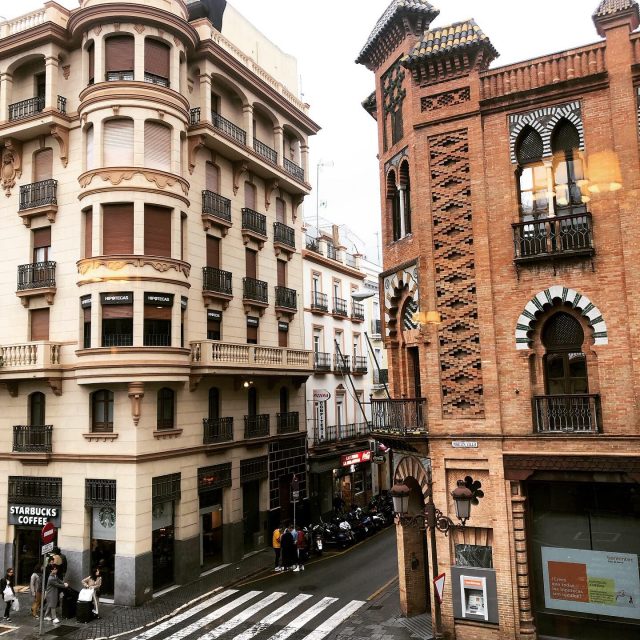 In contrast to the Congressional area, the roads in downtown Seville are more reminiscent of narrow and zigzagging European roads. They amazingly accommodate both pedestrians and cars, which squeeze by. The pathways are usually filled with plentiful options for patio dining. The famous Santa Cruz neighborhood is right by the Giralda tower and main Cathedral (burial place of Christopher Columbus).
In contrast to the Congressional area, the roads in downtown Seville are more reminiscent of narrow and zigzagging European roads. They amazingly accommodate both pedestrians and cars, which squeeze by. The pathways are usually filled with plentiful options for patio dining. The famous Santa Cruz neighborhood is right by the Giralda tower and main Cathedral (burial place of Christopher Columbus). 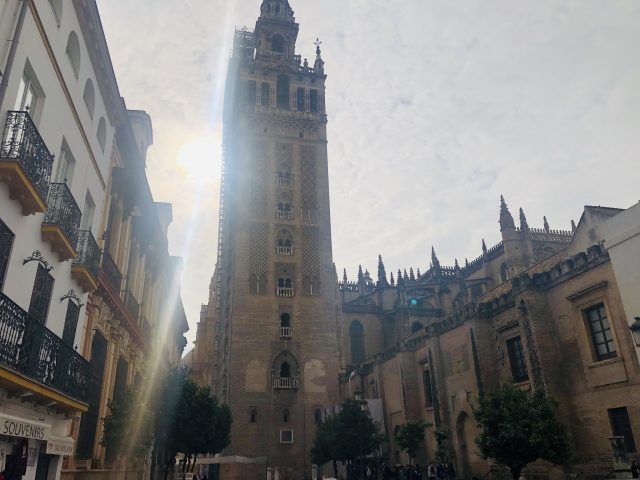 Although there is a hotel right across the street from the tournament hall, where naturally most of the players stayed, I chose another option further down the avenue. It had unbelievably priced junior suites available, along with a sleek modern design.
Although there is a hotel right across the street from the tournament hall, where naturally most of the players stayed, I chose another option further down the avenue. It had unbelievably priced junior suites available, along with a sleek modern design.
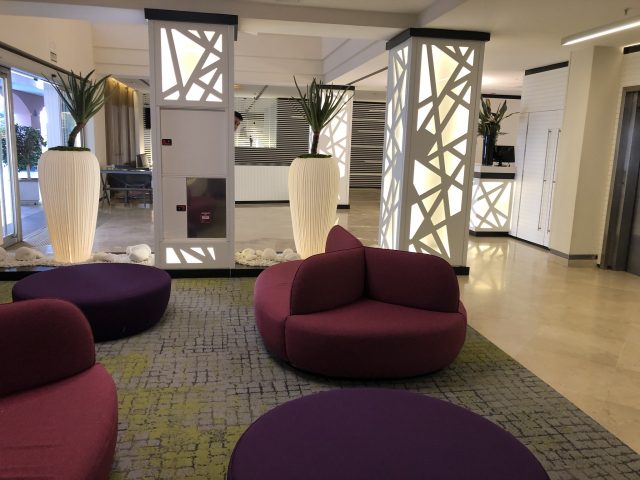 Can you spot the hidden Raja in the hotel lobby?
Can you spot the hidden Raja in the hotel lobby?The public bus regularly stopped directly outside the FIBES center and the hotel, and thus provided an efficient option for getting to/from the playing site in about ten minutes.
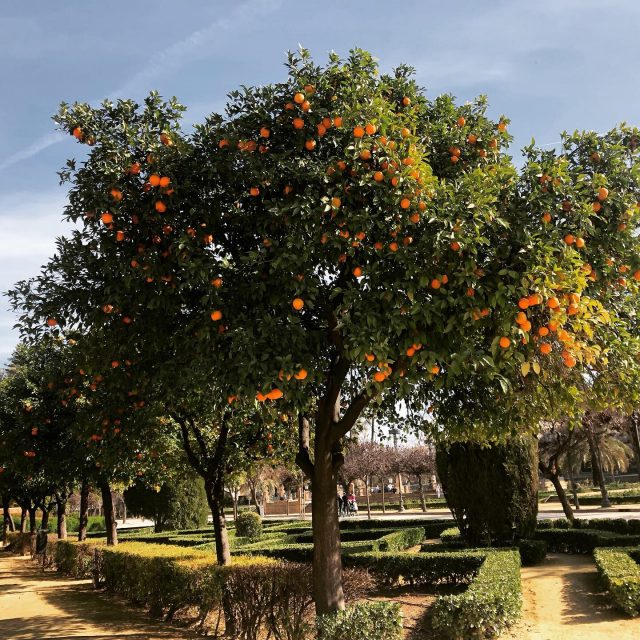 The streets of Seville are adorned with palm trees and orange trees. Sometimes it felt like being in Florida.
The streets of Seville are adorned with palm trees and orange trees. Sometimes it felt like being in Florida.The tournament hall was prepared to host the 300 participants all signed up to play in the single, open section. Tournament chess sets and digital clocks were dutifully set up for all boards (an unheard-of luxury for US tournaments of this magnitude). Name cards with a player’s federation and rating were prepared for each participant. There was a roped area for the top 17 DGT boards that were broadcast live. 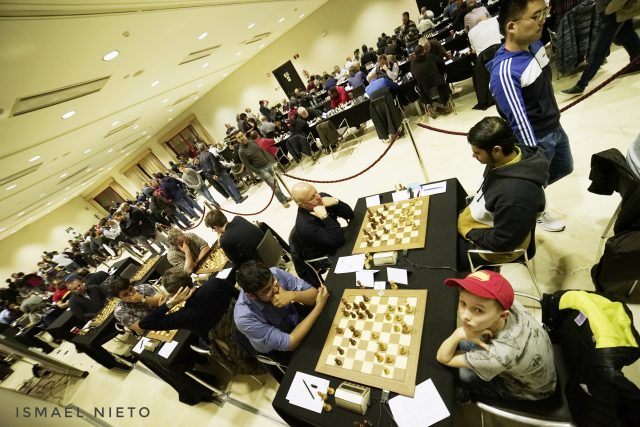
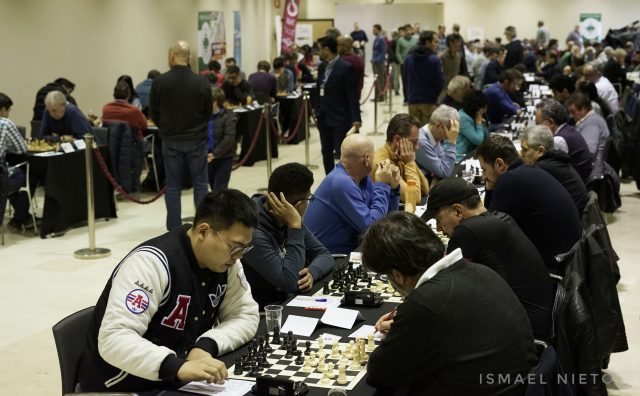 It was wonderful to see so much local interest in the games, but the spectators occasionally had to be reminded to keep their voices down. The several times I ended up in the roped off area—where most of the boards tended to be set up in pairs—I felt like I had slightly less room for my board and scoresheet than in the general area. Part of the issue is that cups were not allowed near the DGT boards, and given there were no side tables, water had to be placed on the floor. Aside from this minor point, it was palpable that the organizers were passionate about the event and put in a lot of work to make it run smoothly.
It was wonderful to see so much local interest in the games, but the spectators occasionally had to be reminded to keep their voices down. The several times I ended up in the roped off area—where most of the boards tended to be set up in pairs—I felt like I had slightly less room for my board and scoresheet than in the general area. Part of the issue is that cups were not allowed near the DGT boards, and given there were no side tables, water had to be placed on the floor. Aside from this minor point, it was palpable that the organizers were passionate about the event and put in a lot of work to make it run smoothly.
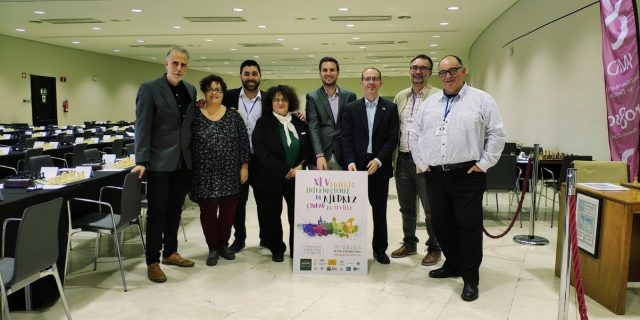 Seville Open Organizers and Staff. Photo Ismael Nieto
Seville Open Organizers and Staff. Photo Ismael Nieto An admirable feature of the tournament hall, and a further sign of the organizer’s commitment, was the right-hand back row. This was designated to accommodate visually impaired players of varying degrees—something that despite my extensive experience in US open tournaments, I had never directly encountered before. 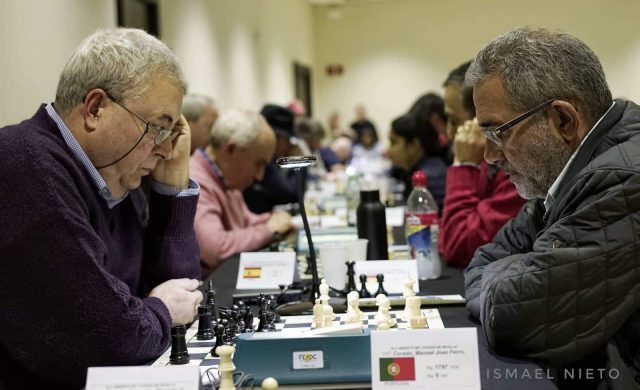
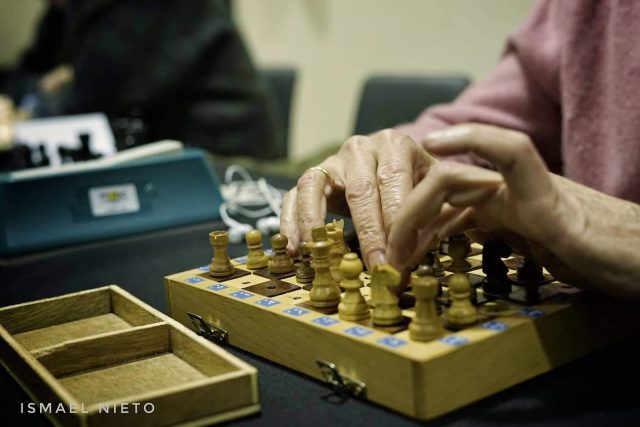 In round 7, I had the pleasure of playing against one these players in a highly tense game with no piece or pawn exchanges until my opponent sacrificed a knight on move 15.
In round 7, I had the pleasure of playing against one these players in a highly tense game with no piece or pawn exchanges until my opponent sacrificed a knight on move 15.
[pgn] [Event "Sevilla Open 2020"] [Site "?"] [Date "2020.01.16"] [White "Fernandez Lago, David"] [Black "Melekhina, Alisa"] [Result "0-1"] [ECO "B06"] [WhiteElo "1924"] [BlackElo "2192"] [SetUp "1"] [FEN "rnbqk2r/4npb1/2ppp1pp/pp6/3PP2P/PBN1BQ2/1PP2PP1/R3K1NR w KQkq - 0 10"] [PlyCount "34"] [EventDate "2020.??.??"] [WhiteTeam "ESP"] [BlackTeam "USA"] 10. Nh3 Nd7 11. h5 {setting the stage for the sacrifice that is the core of white's plan at the moment.} g5 12. Qg3 d5 {This move was almost forced, but it was also the right time to challenge the structure of the center.} 13. f3 Nb6 (13... Qb6 {Apparently this move gives black the advantage because of the challenge to d4 and preparing a break with b4. However, I was already focused on maneuvering my knight to c4.} 14. Rd1 a4 15. Ba2 b4 16. axb4 Qxb4 $17 17. Nxg5 {this is white's main aim, but doesn't work in this line either.} hxg5 18. Bxg5 Qxb2 19. f4 c5 $1 20. Bxe7 Bxd4 21. Rh3 Kxe7 $19) 14. Rd1 Ba6 15. Nxg5 Rg8 {A tricky reply that puts the ball back in white's court. What next?} (15... hxg5 {was possible after all, but requires finding a few courageous moves.} 16. Bxg5 Rg8 17. Bxe7 Kxe7 $1 (17... Qxe7 18. h6 {White regains the piece and the advantage.}) 18. Qh4+ Bf6 {blocks the impending threats.}) 16. Nxf7 {In the spirit of the position, but after Rg8 black has sufficient defensive resources. } (16. Nh7 {The counterintuitive idea is that this defends the threat of the discovery behind Bxd4 by counterattacking with the Nf6 fork. This leads to a number of wild computer lines. Black can hold with the also counterintuitive Nd7 retreat and avoid the messy continuations.} Nd7 (16... b4 {or preferably, start with b4 and then lock in Nd7.} 17. axb4 axb4 18. Na2 Nd7) (16... Bxd4 17. Bxd4 Rxg3 18. Nf6+ Kf8 19. Nh7+ Kg8 20. Nf6+ Kg7 {if Black tries to run from the perp...} 21. Nfxd5+ $1 f6 22. Nxb6 c5 $1 (22... Qe8 $2 23. Nxa8 Qxa8 24. Bxe6 $18) 23. Bxf6+ Kxf6 24. Rxd8 Rxd8 $11)) (16. Bf4 {I was expecting this move, which is difficult to play against. White maintains the tension in the position and shifts the onus back on black to untangle, while causing discomfort on the h2-b8 diagnoal.} Ra7) 16... Kxf7 17. Rh4 Bf6 (17... Bxd4 $1 { was even more powerful, even though I was proud of finding Bf6 and the intricate lines that might have followed.} 18. Qf4+ (18. Rf4+ Ke8 19. Qf2 Bxe3 20. Qxe3 b4 $19) 18... Nf5 19. exf5 e5 $1) 18. Rg4 (18. Qf4 Nf5 $1 19. exf5 Bxh4+ 20. Kd2 Rxg2+ 21. Kc1 Bg5 22. fxe6+ Kxe6 23. Qe4+ Kd7 24. Qf5+ Kc7 { The king escapes with no consequences.}) 18... Rxg4 19. Qxg4 Qg8 20. Bxh6 (20. Qh3 {White needs to try to keep the queens on the board. Once exchanged, I am free of the complications and it is smooth sailing.}) 20... Qxg4 21. fxg4 Rg8 22. Rd2 Bh4+ 23. Kd1 Rxg4 24. exd5 Nbxd5 25. Nxd5 cxd5 26. c3 Nf5 {An unexpected trapping of the bishop to end the game.} 0-1[/pgn]
During the game, I had my own regular chess set. We shared a digital clock in between both sets that would be pressed at a normal pace. The visual clock display was facing me, while my opponent had access to headphones that would dictate the times to him upon pressing a button. Upon making a move on my own set, I would verbalize it to my opponent, and he would do the same with his reply, which I would then manually move on my set. He would do the same on his own, specially equipped set that allowed him to precisely insert the pieces into the correct squares, and literally feel the pieces as necessary. It was this aspect of “feeling the position” that struck me. We are used to conceptualizing chess by either visual or algorithmic means. However, it is rarely a tactile experience. As my opponent felt the pawn masses on the Queenside with his hand, I wondered at the novel adaptation one could give to a position. For example, we describe weak pawns based on what they are inhibited from doing and the adjacent weak squares, but what if we instead derived value based on feeling the difference between an island of doubled pawns and a formidable pawn chain? I certainly appreciated the new perspective. All of the local Spanish players I encountered seemed to relish the opportunity to play against titled foreigners. Everyone was a gracious sport after the game. I thought that this might have something to do with the curiosity that the pairings did not change a single time throughout the entire tournament. In a US open tournament, just given the sheer magnitude of players and whims, one might expect drop-outs or complaints. Yet here, it was smooth sailing. The pairings were always up on time on the easy-to-navigate tournament website. Because the arbiters were hard at work enforcing and collecting signed scoresheets after the completion of a game and inputting the results as soon as possible, the next pairings were up in just a few hours after the evening round concluded. In fact, I joked that they went up too quickly and didn’t provide enough time to internalize the recent game! The caveat is that quick pairings introduced the temptation of late-night prep even though we had the entire following day to prepare. The round times were at 5:30 PM every day (except for the final round at 9:30 A.M.) for eight consecutive days with a time control of 90 minutes and 30’ second increment for the entire game. The Sofia rule against draws before move 30 was in place. The evening round time (accommodating the Spanish afternoon siesta period), was also a big draw for me in deciding to play. A daily evening round opened up the entire day for enjoying the city. Before the event, I vowed to avoid falling into the trap of preparing all day and to truly take advantage of my vacation time. Raja had the clever idea of going out on days when we had white and considering using our black days for more prep time. It helped that we both started out paired with the same colors. For the most part, we stuck to our itinerary and managed to squeeze in just the right amount of vacation and prep.
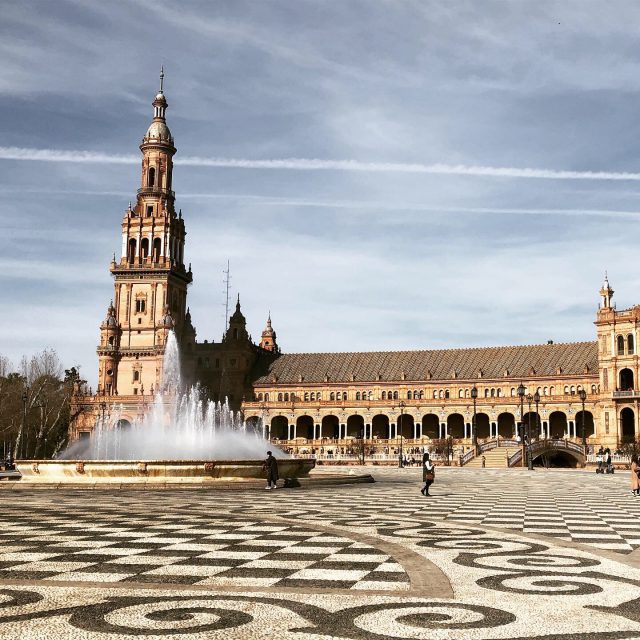 We saw the stunning Plaza de España in the Parque de María Luisa on our first day out, which set the tone for the sights for the rest of the trip.
We saw the stunning Plaza de España in the Parque de María Luisa on our first day out, which set the tone for the sights for the rest of the trip.We managed to see a little bit of everything day-by-day and combine it with a tapas tasting while we were at it. 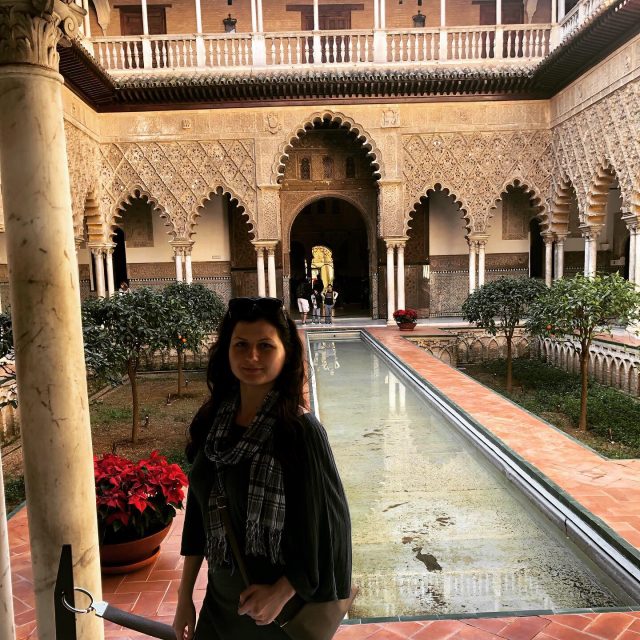
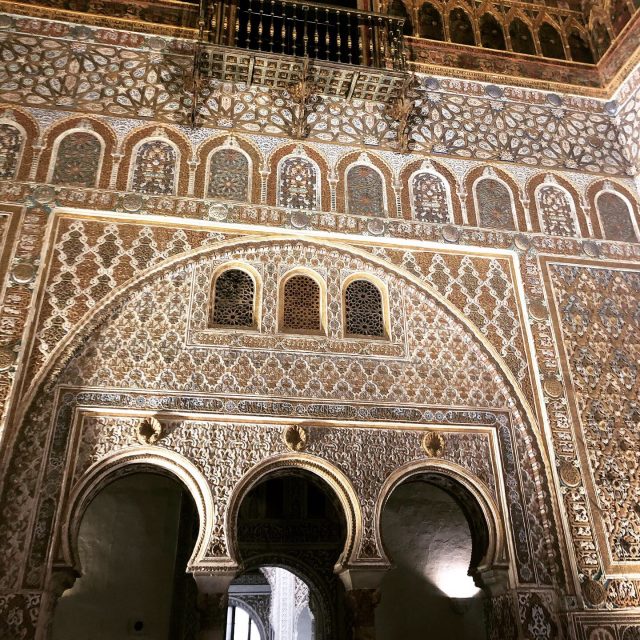 The Royal Alcázars of Seville Palace is a tourist hotspot after serving as a shooting site for Game of Thrones. It features unique architecture and mosaics, along with access to sprawling backyard gardens.
The Royal Alcázars of Seville Palace is a tourist hotspot after serving as a shooting site for Game of Thrones. It features unique architecture and mosaics, along with access to sprawling backyard gardens.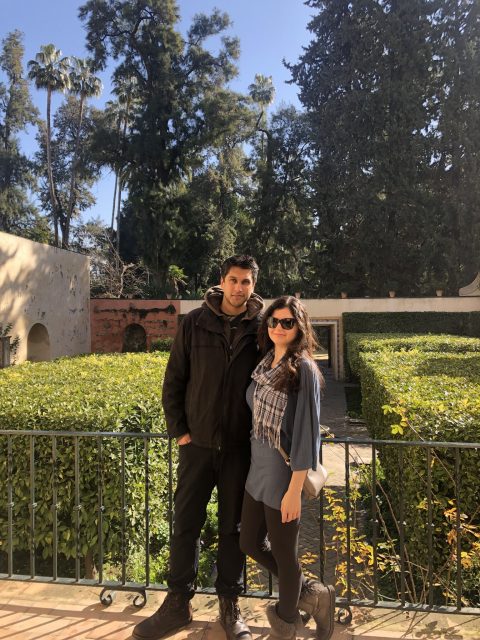 FM Alisa Melekhina and IM Raja Panjwani exploring the Alcazar gardens in their free time.
FM Alisa Melekhina and IM Raja Panjwani exploring the Alcazar gardens in their free time.We didn’t target any specific restaurants, but played it by ear in evaluating the English menus when available. As long as you walk just a few blocks away from the main tourist areas to avoid the over-priced tourist bait, you’re bound to run into an inviting dining spot, and our expectations were always exceeded.
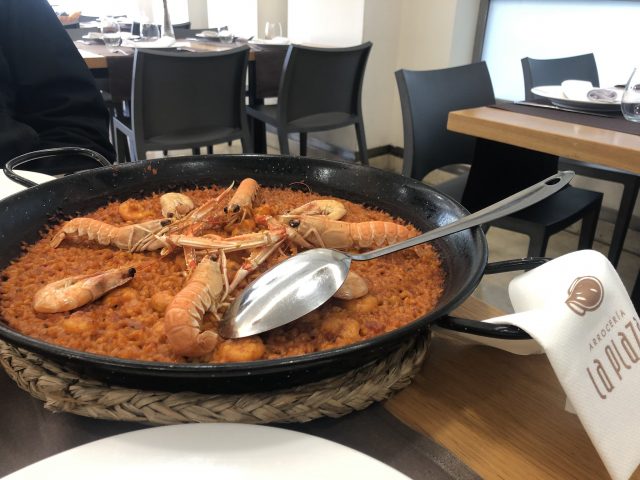 We learned our lesson about what a seafood paella really contains in Spain. Prawn promotion.
We learned our lesson about what a seafood paella really contains in Spain. Prawn promotion.The few years of Spanish I took in college came in handy throughout the trip. Aside from those servicing the tourist industry such as the staff in the airport, train terminal, hotel, or popular restaurants, communicating in English with some drivers or locals was not really an option in Seville. Not that it should be an impediment to visiting the city, but rather, it enhanced my experience. I picked up some Spanish chess-related vocabulary as well, especially when hearing players analyze.
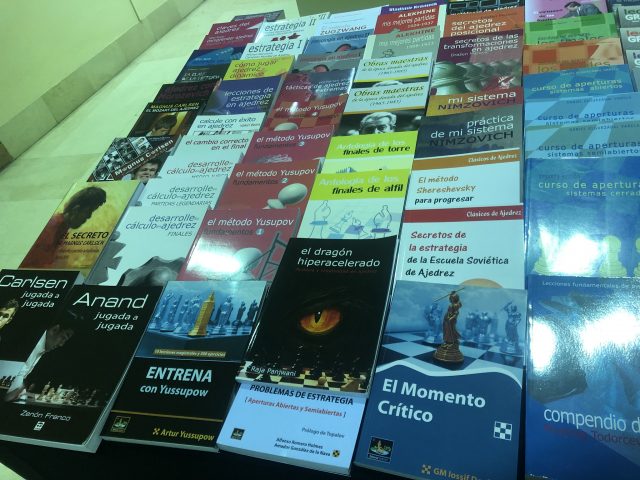 Raja’s popular opening book on the Hyper Accelerated Dragon was among the Spanish translations sold in the book stand outside the tournament hall.
Raja’s popular opening book on the Hyper Accelerated Dragon was among the Spanish translations sold in the book stand outside the tournament hall.Although the main tournament organizers of course spoke English and the important announcements were translated, the routine tournament announcements such as when to take seats and begin games were in Spanish. Overall, it was an immersive experience. The majority of the tournament players were Spanish, although there were reasonably sized delegations of stronger players from China and India. The clear winner of the tournament with 8.5/9 hailed from Ukraine: GM Kirill Shevchenko.
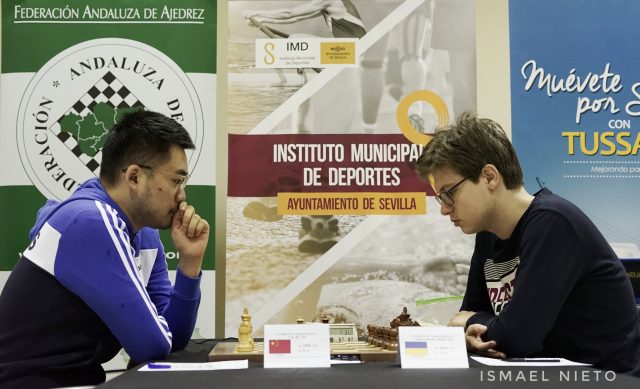 The Seville Open winner was the 17-year-old GM Shevchenko from Ukraine. Photo Ismael Nieto
The Seville Open winner was the 17-year-old GM Shevchenko from Ukraine. Photo Ismael NietoAt least at my level, I spent 6/9 rounds playing opposition rated lower than 2000 Fide. These up/down swings are expected in a tournament of this size where there is only one section that tends to be more middle/bottom heavy. (Of course, that could change soon when this tournament gains more popularity!) It’s not that norms are completely off the table, but there is a lot of weight on the few games where you do play up. If you don’t take advantage of those opportunities, you’re back to the drawing board in playing down for 2-3 more rounds until you can make it back to the top for another chance. It could also be risky if you are focused on rating, because one small slip-up against a lower-rated player could have a devastating effect and it is not as easy to bounce back. On the other hand, this also means that you could have an easier overall time so long as you beat whom you are supposed to beat. Because the partial purpose of this trip was a vacation, I preferred this tournament approach with less prep focus even if it was a bit riskier. I ended up beating all those lower-rated than me and losing to the higher-rated for a final score of 6/9, tying for 28th place and just outside the main prizes. There were 20 cash Euro prizes ranging from 2,000 euros for first place to 50 for twentieth, with several brackets of class and local prizes in the several hundred range. If you’re having a decent tournament in the plus, you have a good chance to come away with something for your efforts. Even though there were no prizes for top female as is more typical in European tournaments, the event already had a healthy mix of strong foreign female players. Among these were IM Padmini Rout from India (one of my losses) and WIM Tianlu Gu from China (who drew Raja in round 6). 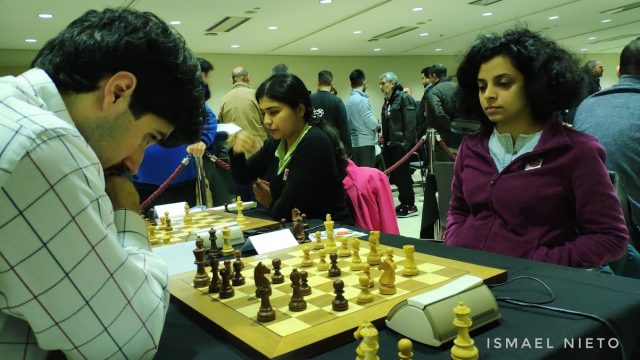 In my final round, I ended up winning in another tense game that —as is typical for me for some reason— was one of the last to conclude.
In my final round, I ended up winning in another tense game that —as is typical for me for some reason— was one of the last to conclude.
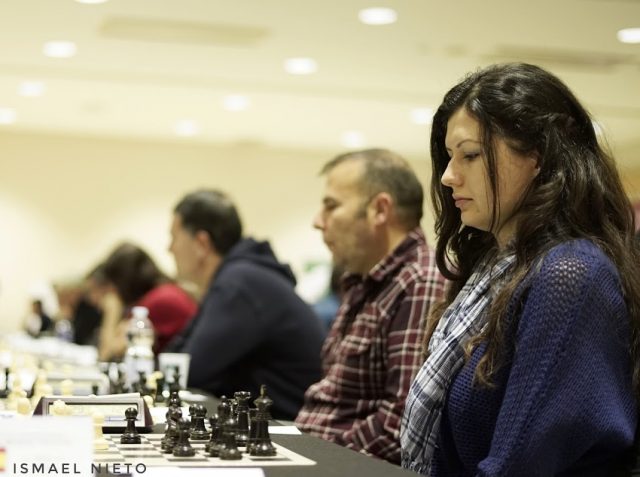 FM Alisa Melekhina in the final round of the Seville Open. Photo Ismael Nieto
FM Alisa Melekhina in the final round of the Seville Open. Photo Ismael Nieto[pgn] [Event "Sevilla Open 2020"] [Site "?"] [Date "2020.01.18"] [White "Barrera Martinez, Francisco"] [Black "Melekhina, Alisa"] [Result "0-1"] [ECO "E91"] [WhiteElo "1932"] [BlackElo "2192"] [PlyCount "110"] [EventDate "2020.??.??"] [WhiteTeam "ESP"] [BlackTeam "USA"] 1. d4 Nf6 2. c4 g6 3. Nc3 Bg7 4. e4 d6 5. Be2 O-O 6. Nf3 c5 7. d5 e5 8. dxe6 Bxe6 9. O-O Qb6 10. Qb3 Qxb3 11. axb3 {Typically in KID structures, Black should avoid queen exchanges. In the classical lines, Black usually has a dark-squared bishop and relies on a quick attack fueled by tactical opportunities. However, this line has taken a positional turn. The dark-squared bishop is now strong, and black has targets to play for in white's position, namely the d4 and b4 squares. It doesn't hurt that white's potential queenside counterplay is now stunted.} Nc6 12. Bf4 Rfd8 13. Rfd1 Ne8 14. Bg5 (14. Nb5 Bxb2 {The b2 pawn is a liability which hinders white from mounting pressure on d6.}) 14... Rd7 15. Na4 Rb8 {Countering the insidious Nb6 fork.} 16. Bh4 b6 17. Nc3 Bg4 {If you take anything away from this game, please let it be the lesson that white should have prevented this Bxf3 exchange a long time ago with h3. Now, black's control of d4 becomes uncontested, which was my dominant plan from the beginning.} 18. Bg3 h5 {No rush to take on f3 unprovoked, especially since white can't yet move the knight because of Bxe2, Nxe2, and Bxb2. h5 is especially helpful here for preventing white from causing trouble with Bg4 after the exchange.} 19. h3 Bxf3 20. Bxf3 Nd4 21. Ra6 {Giving up a pawn, but I think it is the correct plan for white after all. It creates some practical chances in the ensuing complications.} Nxb3 22. e5 Nd4 23. exd6 Nxd6 24. Rxd4 cxd4 25. Nb5 (25. Ne4 {was a better try because Bf8 is no longer possible. Instead, I would have had to find amazing, only moves to keep the advantage.} Re8 (25... Bf8 $2 26. Nf6+) 26. Nxd6 Re1+ 27. Kh2 d3 28. Bf4 g5 $1 29. Bd2 Be5+ 30. g3 Re2 31. Bxe2 dxe2 32. c5 bxc5 $19) 25... Bf8 26. c5 {keeping the pressure on.} Nxb5 27. Bxb8 bxc5 {I had to decide whether to recapture with the b pawn or bishop. The pawn made more sense sicne it would provide connected pawns and lead to a pin down the b-file in the line that I thought was most likely to occur.} 28. Bc6 Rd8 29. Bxb5 Rxb8 {with a tempo compared to if I had captured Bxc5.} 30. Bc4 Rxb2 31. Rxa7 {I am temporarily up two pawns. I have to figure out the optimal way to give up the f7 pawn which I can't hold on to, while preserving winning chances with the opposite-colored bishops.} Rb1+ 32. Kh2 Bd6+ 33. g3 Rc1 {Forcing white to capture f7 with the bishop.} 34. Bxf7+ Kg7 {Fortunately I don't have anything white can reach on light squares after a discovered check!} 35. Bd5+ Kf6 {this looked like the correct approach to centralize the king. However, it got me into an awkward positioning within a mating net. I then had to backtrack upon realizing my mistake when I figured out I had to try an escape route through the back rank.} 36. f4 Be7 {Watch out for Rf7#.} 37. g4 Re1 {The instinct might be to recapture on g4, but that doesn't alleviate the mating net. I also need the h pawns to create a potential second weakness under the "principle of two weaknesses."} 38. Bc4 Re3 39. Rd7 h4 $1 {Now white's king is the one uncomfortable.} 40. Rb7 Kg7 { Realizing that to make progress I need to free my king the long way.} 41. Rd7 $2 {This seemingly innocuous move allows me to continue with my plan. Instead, white needs to keep the rook far enough from the king. If he simply moves his king back and forth, it is difficult for me to make progress as the d-pawn is still too weak to promote.} (41. Kg2 Kf8 42. Rb8+ Kg7 43. Rb7 d3 44. Bxd3 $11) 41... Kf8 $1 42. Ra7 Bd6 {With this tempo, I am free and now white has to worry about his own pawn weaknesses around his king.} 43. Kg2 Rg3+ (43... Bxf4 $2 44. Rf7+ {double attack}) 44. Kf2 Rxh3 45. Rf7+ Ke8 46. Rf6 Ke7 47. Rf7+ Ke8 48. Rf6 Kd7 49. f5 (49. Rf7+ Kc6 {reaching the ultimate safety zone, as in the game.}) 49... gxf5 50. g5 {a Hail Mary to promote the pawn. But now being three pawns up I have too many resources at my disposal to stop the attempt.} Rh2+ 51. Kg1 Rh3 52. g6 Rg3+ 53. Kh1 h3 54. Rf7+ Kc6 55. g7 h2 {White ran out of time before making the hopeless choice between mate on g1, a discovery after taking on h2, or liquidating into a lost bishop ending.} (55... h2 56. Kxh2 (56. g8=Q Rxg8 57. Rc7+ Kxc7 58. Bxg8 d3 59. Bb3 Kc6 60. Kg2 d2 61. Kh1 c4 62. Ba4+ Kc5 63. Kg2 Kd4 {#9/0}) 56... Rxg7+) 0-1[/pgn]
I was sad to see the tournament come to an end as I watched the pieces around me getting stored away. I built in one free day after the conclusion of the tournament. We originally considered doing a day trip to Granada, which everyone I know who has visited Seville highly recommends. Among considering options, it turned out the travel time would have been over 3 hours each way, and the Granada group tour options were at inconvenient early morning times. So, we decided to save that for another time where we could perhaps budget in more than a single day, and enjoy the last parts of Seville left unexplored. 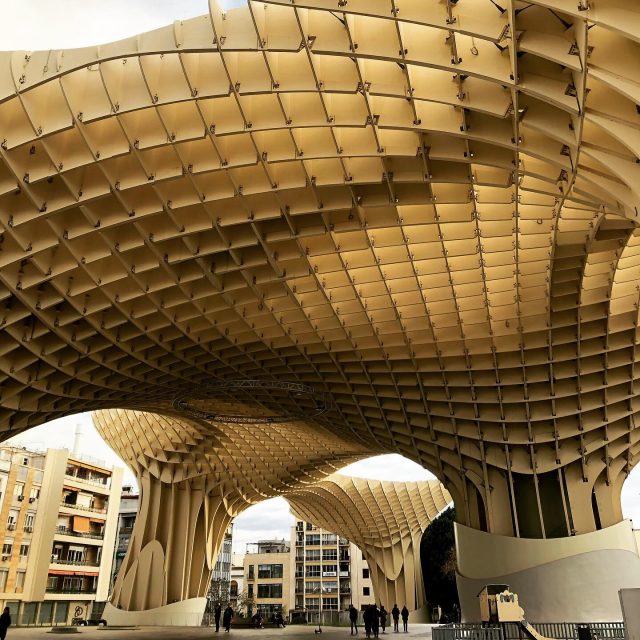 The “Mushroom” structure is a new addition to Seville. Completed in 2011, it adds a modern flare in a nearby shopping and dining area. Still on my to-do list was a must-see Flamenco show, given the dance originated in Andalusia and I got my chance: [video width="608" height="1080" mp4="/sites/default/files/wp-thumbnails/2020/04/1080p.mp4"][/video] The next day, I was due to go to Madrid where I planned to spend 1.5 days before returning home to NYC. Raja took the four-hour bus (there are no direct trains despite the relative proximity) to Gibraltar, which was apparently accompanied by an adventurous and rainy crossing of the border into the British territory by foot. Meanwhile, my direct train from Seville to Madrid was a cool 2 hrs 15 minutes on the efficient and comfortable Renfe line. Upon stepping out of the platform, I could immediately tell that I was back in a large, hustling and bustling city. After figuring out how to descend onto the street from the vertically-constructed Madrid train station (it was like solving an M. C. Escher print), I checked into my hotel and darted out to get as much sight-seeing as possible before my evening flight the next day. Madrid reminded me a lot of Washington DC in the U.S. Other than the fact that they are both the national capitals, Madrid is full of museums and statues.
The “Mushroom” structure is a new addition to Seville. Completed in 2011, it adds a modern flare in a nearby shopping and dining area. Still on my to-do list was a must-see Flamenco show, given the dance originated in Andalusia and I got my chance: [video width="608" height="1080" mp4="/sites/default/files/wp-thumbnails/2020/04/1080p.mp4"][/video] The next day, I was due to go to Madrid where I planned to spend 1.5 days before returning home to NYC. Raja took the four-hour bus (there are no direct trains despite the relative proximity) to Gibraltar, which was apparently accompanied by an adventurous and rainy crossing of the border into the British territory by foot. Meanwhile, my direct train from Seville to Madrid was a cool 2 hrs 15 minutes on the efficient and comfortable Renfe line. Upon stepping out of the platform, I could immediately tell that I was back in a large, hustling and bustling city. After figuring out how to descend onto the street from the vertically-constructed Madrid train station (it was like solving an M. C. Escher print), I checked into my hotel and darted out to get as much sight-seeing as possible before my evening flight the next day. Madrid reminded me a lot of Washington DC in the U.S. Other than the fact that they are both the national capitals, Madrid is full of museums and statues.
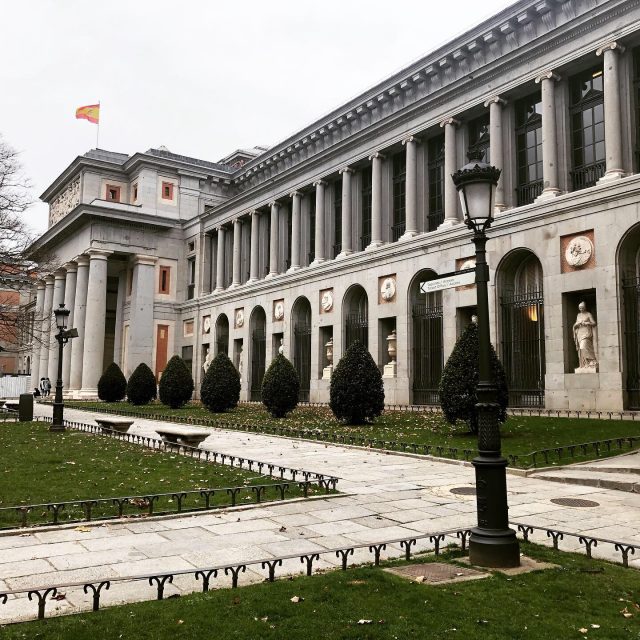 Part of the large Museo del Nacional del Prado, the main Spanish national art museum.
Part of the large Museo del Nacional del Prado, the main Spanish national art museum.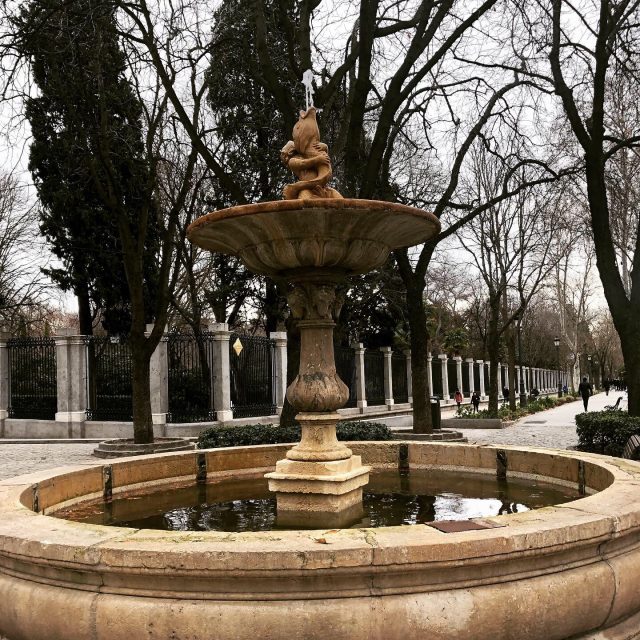 True to its European nature, though, it also has multiple sprawling plazas.
True to its European nature, though, it also has multiple sprawling plazas.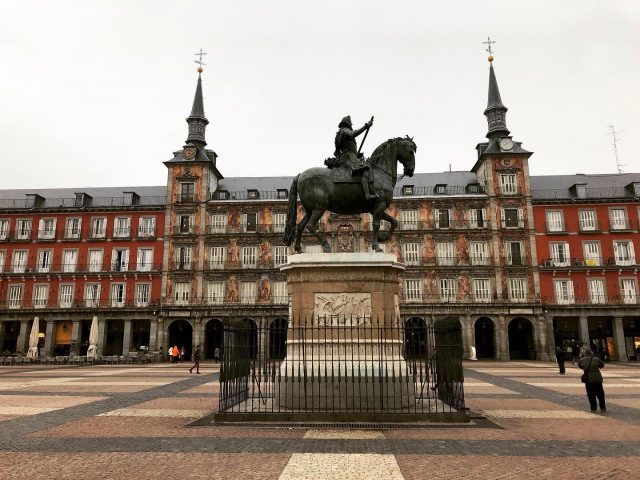 The scenery especially comes alive at night.
The scenery especially comes alive at night.
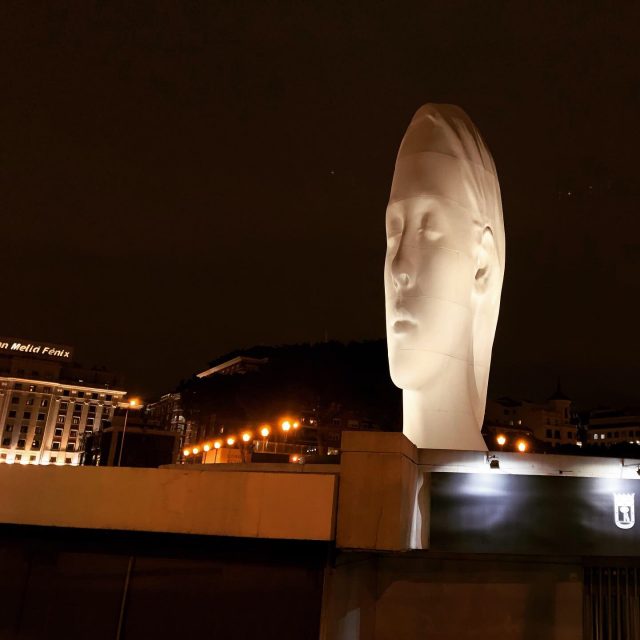 This picture is not distorted; this is how the intriguing Jaume Plensa sculpture of “Julia” appears in real life. The 12-meter high sculpture is meant to convey “tenderness and silence.”
This picture is not distorted; this is how the intriguing Jaume Plensa sculpture of “Julia” appears in real life. The 12-meter high sculpture is meant to convey “tenderness and silence.”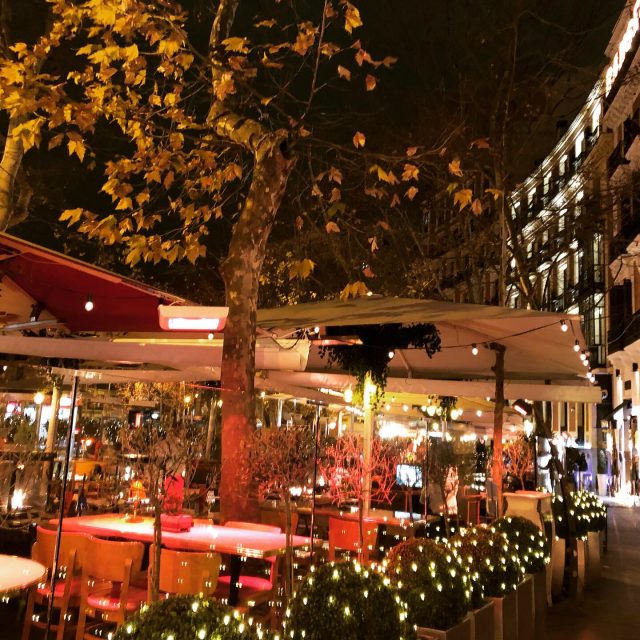 I even managed to fit in another Flamenco show. However, I was soon back in winter temperatures and while the myriad of plazas were impressive, they were not as brightly illuminated as the ones underneath the Seville sun. I look forward to a time where the travels of my care-free January trip are available again as this article serves as a time capsule of just a couple months ago, where we played chess through stamps on our passports. *Select tournament photos were taken by on-site photographer Ismael Nieto and are credited as such in the caption or as indicated by his watermark. All other photos are by Alisa Melekhina. *FM Alisa Melekhina is a World Team Championship gold medalist and long-time competitor in US open tournaments and women’s national and world team invitational events. She graduated from the University of Pennsylvania Law school in May 2014 and is currently practicing as a corporate litigation attorney in NYC. She previously wrote a popular CLO article on Balancing Law School and Chess.
I even managed to fit in another Flamenco show. However, I was soon back in winter temperatures and while the myriad of plazas were impressive, they were not as brightly illuminated as the ones underneath the Seville sun. I look forward to a time where the travels of my care-free January trip are available again as this article serves as a time capsule of just a couple months ago, where we played chess through stamps on our passports. *Select tournament photos were taken by on-site photographer Ismael Nieto and are credited as such in the caption or as indicated by his watermark. All other photos are by Alisa Melekhina. *FM Alisa Melekhina is a World Team Championship gold medalist and long-time competitor in US open tournaments and women’s national and world team invitational events. She graduated from the University of Pennsylvania Law school in May 2014 and is currently practicing as a corporate litigation attorney in NYC. She previously wrote a popular CLO article on Balancing Law School and Chess.
Categories
Archives
- January 2026 (2)
- December 2025 (27)
- November 2025 (29)
- October 2025 (39)
- September 2025 (27)
- August 2025 (29)
- July 2025 (43)
- June 2025 (25)
- May 2025 (24)
- April 2025 (29)
- March 2025 (29)
- February 2025 (20)
- January 2025 (24)
- December 2024 (34)
- November 2024 (18)
- October 2024 (35)
- September 2024 (23)
- August 2024 (27)
- July 2024 (44)
- June 2024 (27)
- May 2024 (31)
- April 2024 (51)
- March 2024 (34)
- February 2024 (25)
- January 2024 (26)
- December 2023 (29)
- November 2023 (26)
- October 2023 (37)
- September 2023 (27)
- August 2023 (37)
- July 2023 (47)
- June 2023 (33)
- May 2023 (37)
- April 2023 (45)
- March 2023 (37)
- February 2023 (28)
- January 2023 (31)
- December 2022 (23)
- November 2022 (32)
- October 2022 (31)
- September 2022 (19)
- August 2022 (39)
- July 2022 (32)
- June 2022 (35)
- May 2022 (21)
- April 2022 (31)
- March 2022 (33)
- February 2022 (21)
- January 2022 (27)
- December 2021 (36)
- November 2021 (34)
- October 2021 (25)
- September 2021 (25)
- August 2021 (41)
- July 2021 (36)
- June 2021 (29)
- May 2021 (29)
- April 2021 (31)
- March 2021 (33)
- February 2021 (28)
- January 2021 (29)
- December 2020 (38)
- November 2020 (40)
- October 2020 (41)
- September 2020 (35)
- August 2020 (38)
- July 2020 (36)
- June 2020 (46)
- May 2020 (42)
- April 2020 (37)
- March 2020 (60)
- February 2020 (38)
- January 2020 (45)
- December 2019 (34)
- November 2019 (35)
- October 2019 (42)
- September 2019 (45)
- August 2019 (56)
- July 2019 (44)
- June 2019 (35)
- May 2019 (40)
- April 2019 (48)
- March 2019 (61)
- February 2019 (39)
- January 2019 (30)
- December 2018 (29)
- November 2018 (51)
- October 2018 (45)
- September 2018 (29)
- August 2018 (49)
- July 2018 (35)
- June 2018 (31)
- May 2018 (39)
- April 2018 (31)
- March 2018 (26)
- February 2018 (33)
- January 2018 (30)
- December 2017 (26)
- November 2017 (24)
- October 2017 (30)
- September 2017 (30)
- August 2017 (31)
- July 2017 (28)
- June 2017 (32)
- May 2017 (26)
- April 2017 (37)
- March 2017 (28)
- February 2017 (30)
- January 2017 (27)
- December 2016 (29)
- November 2016 (24)
- October 2016 (32)
- September 2016 (31)
- August 2016 (27)
- July 2016 (24)
- June 2016 (26)
- May 2016 (19)
- April 2016 (30)
- March 2016 (36)
- February 2016 (28)
- January 2016 (32)
- December 2015 (26)
- November 2015 (23)
- October 2015 (16)
- September 2015 (28)
- August 2015 (28)
- July 2015 (6)
- June 2015 (1)
- May 2015 (2)
- April 2015 (1)
- February 2015 (3)
- January 2015 (1)
- December 2014 (1)
- July 2010 (1)
- October 1991 (1)
- August 1989 (1)
- January 1988 (1)
- December 1983 (1)


